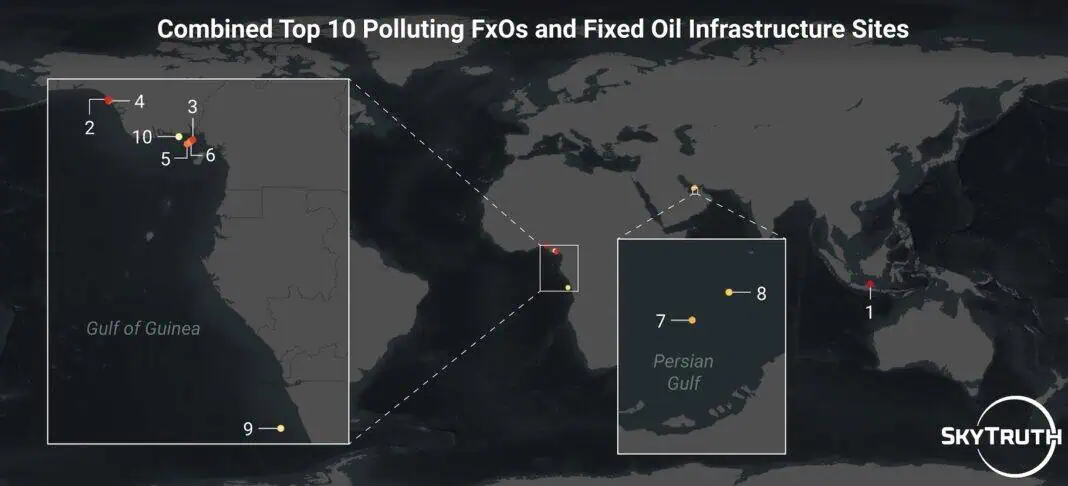Environmental watchdog organization SkyTruth has released a groundbreaking report that identifies and ranks the world’s most polluting offshore oil and gas facilities.
Using advanced satellite technology, researchers documented persistent oil slicks, greenhouse gas emissions and methane flaring at offshore sites around the globe, revealing a pattern of environmental damage that has largely gone undetected until now.
The report, “Exposing the Environmental Costs of Offshore Oil: Greenhouse Gas Emissions, Oil Slicks, and Flaring,” provides the first-ever public data about threats from offshore oil infrastructure based on 16 months of monitoring.
The research was conducted using Cerulean, the world’s first free, publicly available technology developed by SkyTruth that uses artificial intelligence and satellite imagery to track ocean oil pollution and identify potential sources.
Findings will be presented at the Our Ocean Conference in Busan, Korea April 28-30 as part of the Digital Oceans: Actions for Advancing Sustainable Ocean through Digital Technology theme of this annual event.
According to Christian Thomas, Geospatial Engineer at SkyTruth and co-author of the report:
“Despite the urgent climate crisis, offshore oil production continues to expand globally, often with little public scrutiny. By making this critical data publicly available, we aim to empower communities, regulators, and advocacy organizations with the information needed to hold polluters accountable and ensure marine protection.”
The report’s key findings include:
- Chronic Oil Pollution: Researchers identified ten offshore sites that stood out for the frequency and extent of oil slicks, collectively responsible for at least 216,000 gallons (over 5,100 barrels) of oil detected on ocean surfaces.
- Floating Facilities Present Higher Risk: Floating production and storage vessels (FxOs) are disproportionately represented among severe polluters, accounting for four of the ten most polluting assets observed globally, despite making up a small fraction of total infrastructure.
- Geographic Hotspots: The most polluting offshore oil infrastructure is concentrated in West Africa, particularly Nigeria, which hosts five of the ten most polluting FxOs observed. The United Kingdom, Norway, Angola, and the United Arab Emirates also host multiple facilities among the worst polluters.
- Massive Methane Flaring: In 2023, offshore oil and gas operators flared over 23 billion cubic meters of natural gas, generating approximately 60 million metric tons of CO2. The largest sources were linked to infrastructure in Iran, Nigeria, and Mexico.
- Significant Vessel Emissions: Vessel traffic to offshore oil and gas facilities generated at least 9 million metric tons of CO2 in 2023—a carbon footprint larger than many small countries.
The report notes:
“Our research demonstrates that policymakers must account for the substantial site-specific pollution burden imposed by offshore fossil fuel development. FxOs and other infrastructure are causing significant local contamination globally, with demonstrable impacts on marine ecosystems and significant risks for food security, public health, and coastal economies.”
The report highlights that while nearly three-quarters of new oil production volumes are located offshore, monitoring these operations is more crucial than ever. Unlike transient shipping pollution, these stationary facilities cause recurring environmental damage to the same ecosystems and communities.
Thomas added:
“As satellite technology and open-source analytical tools continue to advance, they will drive unprecedented transparency and accountability in this historically opaque sector of the fossil fuel industry. The increasing deployment of FxOs to access deeper offshore reserves indicates this is not merely a legacy issue with aging infrastructure, but a growing environmental challenge.”
To read the full report, go to SkyTruth.

